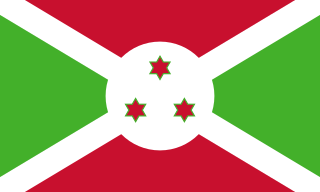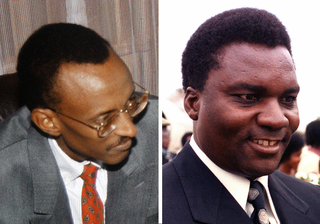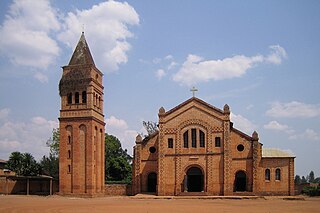
Burundi is one of the few countries in Africa, along with its closely linked neighbour Rwanda among others, to be a direct territorial continuation of a pre-colonial era African state.
Human occupation of Rwanda is thought to have begun shortly after the last ice age. By the 16th century, the inhabitants had organized into a number of kingdoms. In the 19th century, Mwami (king) Rwabugiri of the Kingdom of Rwanda conducted a decades-long process of military conquest and administrative consolidation that resulted in the kingdom coming to control most of what is now Rwanda. The colonial powers, Germany and Belgium, allied with the Rwandan court.
The Hutu, also known as the Abahutu, are a Bantu ethnic or social group native to the African Great Lakes region of Africa, primarily area now under Burundi and Rwanda. They mainly live in Rwanda, Burundi, and the eastern Democratic Republic of the Congo, where they form one of the principal population divisions alongside the Tutsi and the Twa.

The International Criminal Tribunal for Rwanda was an international court established in November 1994 by the United Nations Security Council in Resolution 955 in order to judge people responsible for the Rwandan genocide and other serious violations of international law in Rwanda, or by Rwandan citizens in nearby states, between 1 January and 31 December 1994.

The Rwandan genocide, also known as the genocide against the Tutsi, was a mass slaughter of Tutsi in Rwanda during the Rwandan Civil War, which had started in 1990. It was directed by members of the Hutu majority government during the 100-day period from 7 April to mid-July 1994. An estimated 500,000 to 1,000,000 Rwandans were killed, constituting an estimated 70% of the Tutsi population. Additionally, 30% of the Pygmy Batwa were killed. The genocide and widespread slaughter of Rwandans ended after the Tutsi-backed and heavily armed Rwandan Patriotic Front (RPF), led by Paul Kagame, took control of the capital and the country. An estimated 2,000,000 Rwandans, mostly Hutu, were displaced and became refugees.

Banyamulenge, sometimes called "Tutsi Congolese", is a term historically referring to the ethnic Tutsi concentrated on the High Plateau of South Kivu, in the eastern region of the Democratic Republic of the Congo, close to the Burundi-Congo-Rwanda border.

The Rwandan Civil War was a conflict between the Rwandan Armed Forces, representing the government of Rwanda, and the rebel Rwandan Patriotic Front (RPF). The war, which lasted from 1990 to 1994, arose from the long-running dispute between the Hutu and Tutsi groups within the Rwandan population. A 1959–1962 revolution had replaced the Tutsi monarchy with a Hutu-led republic, forcing more than 336,000 Tutsi to seek refuge in neighbouring countries. A group of these refugees in Uganda founded the RPF which, under the leadership of Fred Rwigyema and Paul Kagame, became a battle-ready army by the late 1980s.

The Kingdom of Rwanda was a pre-colonial kingdom in East Africa beginning in c. 1081, which survived with some of its autonomy intact under German and Belgian colonial rule until its monarchy was abolished in the Rwandan Revolution. After a 1961 referendum, Rwanda became a republic and received its independence in 1962.

In 2007 the Government of Burundi consisted of a 20-member Council of Ministers appointed by the President. The Council of Ministers, together with the President and Vice-Presidents, forms the executive branch of government in the country.
Since Burundi's independence in 1962, there have been two events called genocides in the country. The 1972 mass killings of Hutus by the Tutsi-dominated army, and the 1993 mass killings of Tutsis by the majority-Hutu populace are both described as genocide in the final report of the International Commission of Inquiry for Burundi presented to the United Nations Security Council in 1996.
The origins of the Tutsi and Hutu people is a major issue in the histories of Rwanda and Burundi, as well as the Great Lakes region of Africa. The relationship between the two modern populations is thus, in many ways, derived from the perceived origins and claim to "Rwandan-ness". The largest conflicts related to this question were the Rwandan genocide, the Burundian genocide, and the First and Second Congo Wars.

Hutu Power is a racist supremacist ideology propounded by Hutu extremists in Rwanda. It led to the 1994 Rwandan genocide against the Tutsi. Hutu Power political parties and movements included the Akazu, the Coalition for the Defence of the Republic and its Impuzamugambi paramilitary militia, and the governing National Republican Movement for Democracy and Development and its Interahamwe paramilitary militia.

The most recent statistics on religion in Rwanda were published by the US Government in 2013, yet the source information dates back to the national Census of 2002, which reports that: 56.9% of the Rwanda's population is Roman Catholic, 26 % is Protestant, 11.1% is Seventh-day Adventist, 4.6% is Muslim, 1.7% claims no or other religious affiliation, and 0.1% practices traditional indigenous beliefs.
The largest ethnic groups in Rwanda are the Hutus, which make up about 85% of Rwanda's population; the Tutsis, which are 14%; and the Twa, 1%. Starting with the Tutsi feudal monarchy rule of the Tenth century, the Hutus were a subjugated social group. It was not until Belgian colonization that the tensions between the Hutus and Tutsis became focused on race, the Belgians propagating the myth that Tutsis were the superior ethnicity. The resulting tensions would eventually foster the slaughtering of Tutsis in the Rwandan genocide. Since then, government policy has changed to recognize one main ethnicity: "Rwandan".
The Rwandan Revolution, also known as the Social Revolution or Wind of Destruction, was a period of ethnic violence in Rwanda from 1959 to 1961 between the Hutu and the Tutsi, two of the three ethnic groups in Rwanda. The revolution saw the country transition from a Belgian colony with a Tutsi monarchy to an independent Hutu-dominated republic.
In African political science, tropical fascism is a type of post-colonial state which is either considered fascist or is seen to have strong fascist tendencies. Gnassingbé Eyadéma, the dictator of Togo from 1967 to 2005, has been considered an example of tropical fascism in Africa. The Hutu Power movement, a Hutu ultranationalist and supremacist movement that organized and committed the Rwandan Genocide aimed at exterminating the Tutsi people of Rwanda, has been regarded as a prominent example of tropical fascism in Africa. The Khmer Rouge regime in Cambodia has been called a tropical fascist regime, as they officially renounced communism in 1981.

On 18–19 October 1965, a group of ethnic Hutu officers from the Burundian military attempted to overthrow Burundi's government in a coup d'état. The rebels were angry about the apparent favouring of ethnic Tutsi minority by Burundi's monarchy after a period of escalating ethnic tension following national independence from Belgium in 1962. Although the Prime Minister was shot and wounded, the coup failed and soon provoked a backlash against Hutu in which thousands of people, including the participants in the coup, were killed. The coup also facilitated a militant Tutsi backlash against the moderate Tutsi monarchy resulting in two further coups which culminated in the abolition of Burundi's historic monarchy in November 1966 and the rise of Michel Micombero as dictator.












